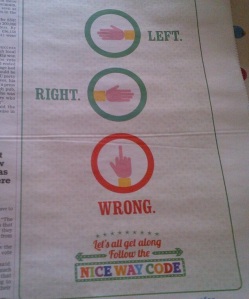Matt Briggs, widower of Kim Briggs and instigator of the Kim Briggs Campaign, recently commented “Not entirely sure why I am expected to fight other people’s causes? My own causes are exhausting enough”.
Mrs Briggs died in February 2016, as a result of injuries sustained in a collision with Charlie Alliston, as he cycled along Old Street, London. Alliston was riding a fixed wheel bike with no front brake and travelling at 18mph. Traffic lights were green in his favour when Mrs Briggs went to cross in front of him. When he swerved to avoid her, she apparently stepped back into his path.
The case has caused controversy and stirred up strong feelings. Alliston was a tabloid editors’ dream. Given the amount of hatred that gets directed at people on bikes, here was someone the press could really get their teeth into. Riding a bike designed for speed, rendered illegal on UK roads by the lack of a front brake, Alliston sounded off on social media, blaming Mrs Briggs for stepping out in front of him and showing little or no apparent remorse for his actions. He was a stereotypically reckless, arrogant young man who seemed to prove every criticism ever thrown at people who cycle. For anyone who does happen to get around on a bicycle, Alliston is a nightmare.
Alliston was found guilty of causing bodily harm by wanton and furious driving and sentenced to 18 months in a young offenders institution. He was cleared of manslaughter. Mr Briggs is now campaigning for a change in the law so that death and serious injury cycling offences are included in the Road Traffic Act.
Mr Briggs has also been tweeting to bicycle manufacturers and sellers, asking them to remove photos of any bikes without front brakes. Such bikes are legal for use on the track, but not on public highways. In addition, bikes are often sold without certain components in the expectation that the buyer will fit appropriate components of their choosing. Bikes are routinely sold without lights, yet these are a legal requirement at night. Many are also sold without pedals as users will want to choose their own and whilst this isn’t a legal requirement, it is obvious that the bikes are not useable without them (and they should have reflectors on the pedals). Many retailers seem to have been receptive to Mr Briggs’ requests and have removed the photographs to which he has objected.
So what are these other causes which Briggs is expected to fight? I can only speak for myself and it is entirely possible that many other people are contacting him with several requests. For me, I don’t expect him to fight causes other than his own. I would however hope that he places his own cause within a greater context – that of road safety in general.
If we consider what happened to Kim Briggs, how could it have been prevented? Well she might have waited until traffic had stopped before she crossed. Alliston might have been travelling slower. He might have had a front brake and stopped more quickly. But these are immediate circumstances which might have been different. They are not an examination of deeper issues.
Old Street is not friendly towards vulnerable road users, either cyclists or pedestrians. It consists of up to four lanes of traffic, including a bus lane. It prioritises motor vehicles. If you’re on foot and in a hurry – tough, you have to wait for motorised traffic to stop. There is a cycle lane in parts and also a shared bus and bike lane, all of which means cyclists are squeezed out. There have been many occasions on busy roads when pedestrians have stepped out in front of me leaving me with no time to brake. Your choices on a bike are limited. You don’t want to hit anybody, you don’t want to go over the handlebars and you don’t want to land in front of a bus or swerve into the path of a lorry. Vulnerable road users do not have space on Old Street, or in the vast majority of the UK’s urban environments.
To survive on the roads, cyclists adopt, and it is recommended that they adopt, a kind of vehicular cycling in which you move at around the same speed as motorised traffic and prominently out into the lane. If the speed limit is 20mph this isn’t too difficult provided you’re fairly fit (although you’ll still get drivers speeding past you). On 30mph roads you need to be very fit.
As a method, vehicular cycling favours young men. You need to be bold, bordering on reckless; assertive bordering on aggressive; and have a confidence that borders on arrogance. All these are things that Wendy Joseph QC criticised Alliston for in her sentencing remarks. Whilst the environment does not excuse his behaviour, we do have to ask why we are creating and maintaining environments which encourage it. As a young man, Alliston belongs to the demographic most likely to be involved in road traffic collisions. We have designed an environment in which what should be faults actually become basic survival tools and in which only those most at risk of causing or being involved in collisions are likely even to try to survive.
So do I expect Matt Briggs to fight his campaign on a wider front? No, not really. His campaign looks to me like a very public expression of grief and although it is public, it is not something I would want to try to influence. What I would hope though is that in time he might come to realise the far greater problem on our roads. Because at the moment, Mr Briggs’ campaign is seized upon as a stick with which to beat anyone travelling by bike when what we should be working out is why our transport system brings us all into conflict.









